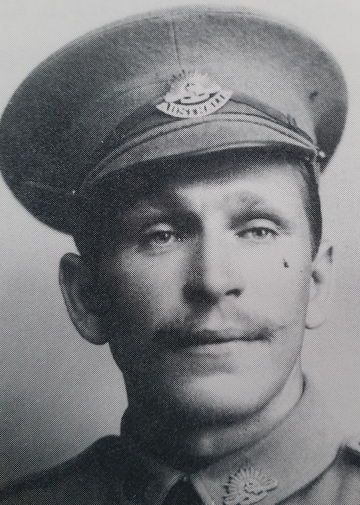
Andreas Adam VOITKUN
Eyes hazel, Hair brown, Complexion fair
Andreas Voitkun - Latvian by birth, Australian by choice
We wish to acknowledge this story sent by Gary Fradd, RSL, Port Pirie SA and inclusion of extracts from Andreas Voitkun’s Memoirs.
Source: Andreas Voitkun's 'Memoirs' in Latvian (1962) (extracts were published in B. & A. Birskys, A. Putniņš and I. Salasoo, The Baltic peoples in Australia: Lithuanians, Latvians, Estonians, Melbourne : AE Press, 1986, pp. 69-72)].
Andreas Adam Voitkun was born in Riga, Latvia on the 29th September 1885 to Anne (Latvian) and Adam Woitkun (Polish) and he had at least one sibling, a sister, Leontine.
With his older sister Leontine together with his wife and two children, Andreas migrated to Australia from London arriving in Adelaide on the 5th April 1913. Andreas had married Emilie Sukke (born 1878) in London not long before sailing. Emilie had two children (presumed to be from an earlier marriage) – Felicitas born 1904 and Otto born 1906. Three more children were born in Australia – twins Alice and Francesca born 1913 and Beatrice Edith born 1915. Shipping records indicate Andreas was a ship engineer by trade. Andreas described his early years as follows:
“My first ten years in Australia were fairly hard. There was hardly any industry because everything was imported from abroad, especially England, and so work was hard to find because frankly there wasn't any work.
One had to take whatever was available. I settled in the small town of Port Pirie. There were more than 25 Latvians working in the lead smelters. Except for myself and one other Latvian family they were all so called lost sons (seamen). A few married local girls but the majority remained bachelors until they died.”

1914: War broke out
The territory of present-day Latvia was originally home to 157 men who served in the Australian Imperial Force (AIF) during the First World War. One of those was Andreas Voitkun:
“I had served in the Russian army and was classified as a Russian army reservist. We had planned to return to our homeland after ten years where I would have been regarded as a refugee if all had been as before without a revolution.
The Russian government announced that all Russian army reservists who found themselves abroad could join any Allied army and would then be regarded as having served in the Russian army.
In 1915 I joined the Australian army and served until the end of the war in Egypt, France and Germany and then from England returned to Australia. I was not the only one. There was a fairly large number of Latvians because from the casualty lists of fallen and wounded one came across many Latvian names such as Kalniņš, Bērziņš and so on. Of course, at that time we were all regarded as Russians because a Latvian government did not exist.”
Leaving Emilie and his now five children at their Agnes Street address in Ellendale, Port Pirie West; Private Andreas Voitkun, service number 2134 enlisted with the 32nd Battalion on the 4th October 1915 in Adelaide, South Australia.

The 32nd Battalion had just been formed in August 1915 with A and B companies from South Australia and C and D companies from Western Australia. The men from WA arrived in Adelaide at the end of August and training for all continued in SA until the original battalion departed for Egypt on 18 November 1915 “with the determination to uphold the newborn prestige of Australian troops”. Source The Register (Adelaide) 16 December 1915, page 6
Andreas was not in this first group but rather remained in training camp for a further few months. His records show that he was assigned to D company. Eventually, he left Adelaide on 7 February 1916 with the 3rd reinforcements for the 32nd on HMAT A24 Miltiades and arrived at Suez on 11 March 1916. Andreas and his group of reinforcements marched into Duntroon Plateau to join the main Battalion on 3 April before then moving on to the Ferry Post staging camp. There they continued training exercises until late May when they headed to Moascar before entraining to Alexandria. The Battalion left Egypt on 17 June 1916 on board HMT Transylvania bound for Marseilles, France where they were to support the British Expeditionary Force on the Western Front.
France and the Battle of Fromelles
The Australian troops were pleased to leave the heat and deserts of Egypt for the gentler European climate. Wesley Choat from A company, for one, was glad to be out of Egypt, but well aware of what lay ahead. Wesley was also to become a prisoner:
“The change of scenery in La Belle France was like healing ointment to our sunbaked faces and dust filled eyes. It seemed a veritable paradise, and it was hard to realise that in this land of seeming peace and picturesque beauty, one of the most fearful wars of all time was raging in the ruthless and devastating manner of "Hun" frightfulness”.
The troops then settled into Morbecque and training continued with a focus on bayonet training and the use of gas masks. D Company’s Lieutenant Sam Mills’ letters home were optimistic for the coming battle:
“We are not doing much work now, just enough to keep us fit—mostly route marching and helmet drill. We have our gas helmets and steel helmets, so we are prepared for anything. They are both very good, so a man is pretty safe.”
On 14 July, they moved into Fleurbaix and were into the trenches two days later. On the 17th they were reconnoitering the trenches and cutting passages through the wires, preparing for their attack, but had to be moved back to Fleurbaix due to bombardment of the trenches.
During the morning of the 18th, A and C companies went back into the trenches to relieve B and D Companies. B and D rejoined the next day and by 4:15pm on the 19th they were readying for their attack. All were in position by 5:45pm. The charges over the parapet began at 5:53pm.

The 32nd was successful in their initial assaults, and by 6:30pm, they were in control of the German’s first line system, which was noted as “practically a ditch with from 1 to 2 feet of mud and slush at the bottom”. However, by 8:30pm their left flank was under heavy bombardment with high explosives and shrapnel. Return bombardment support was provided and the troops were told that “the trenches were to be held at all costs”.
Fighting continued through the night and at 4am, the Germans began their attack from the Australian’s left flank and then on the front. A charge at the Germans’ firing line was made by the Australians, but they were low on grenades and there was machine gun fire from a machine gun from behind from an emplacement at Delangre Farm. They were so far advanced that they were getting shelled by both sides. By 7:30am on the 20th, what was left of the 32nd had withdrawn.
The toll of the attack on the 32nd was devastating – 718 casualties, 90% of their effective strength. Andreas was among the missing.
Prisoner of war - “I am an Australian and a good bit from home.”
Listed as missing in the immediate aftermath of the battle, it eventually became known that Andreas was taken prisoner by the Germans; he was severely wounded by gun shot and shrapnel in the right leg and left arm. He was one of twenty-eight Port Pirie and District personnel taken into captivity during the course of World War 1. For more information on prisoners of war (POW) and the Red Cross see our Website .
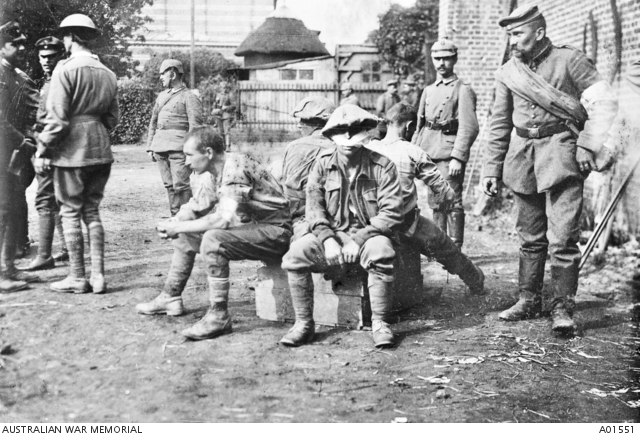
Andreas was in hospital initially at Ohrdruf, eastern Germany, with British and Russian prisoners-of-war. Later camps included Douai and Wahn according to his war record.
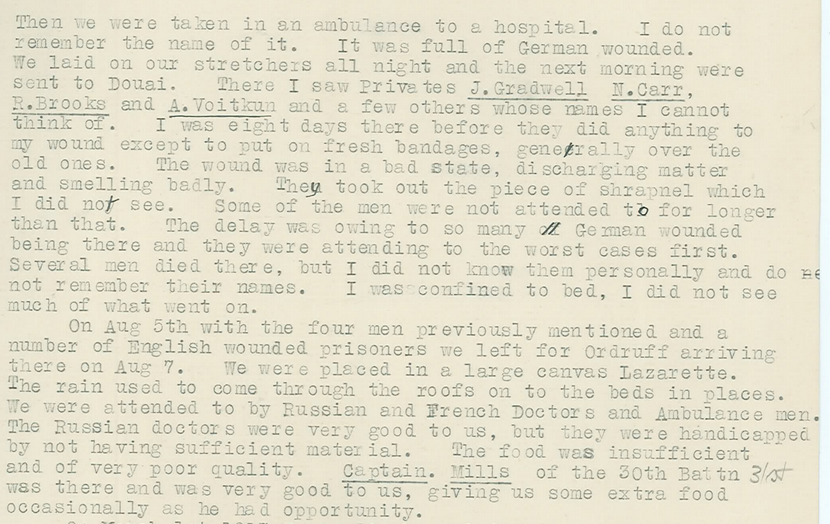
In late August 1916, Andreas wrote to a Mrs E. Wilton Schiff in England seeking help. POWs were reliant on Red Cross packages to ensure they had adequate food and clothing for survival. The delay for Australians to receive help from across the world was considerable due to the huge distances, in addition to the competing demands of rigorous war efforts. In his letter, Andreas describes himself ‘as an Australian and a good bit from home’ – truly an apt description.
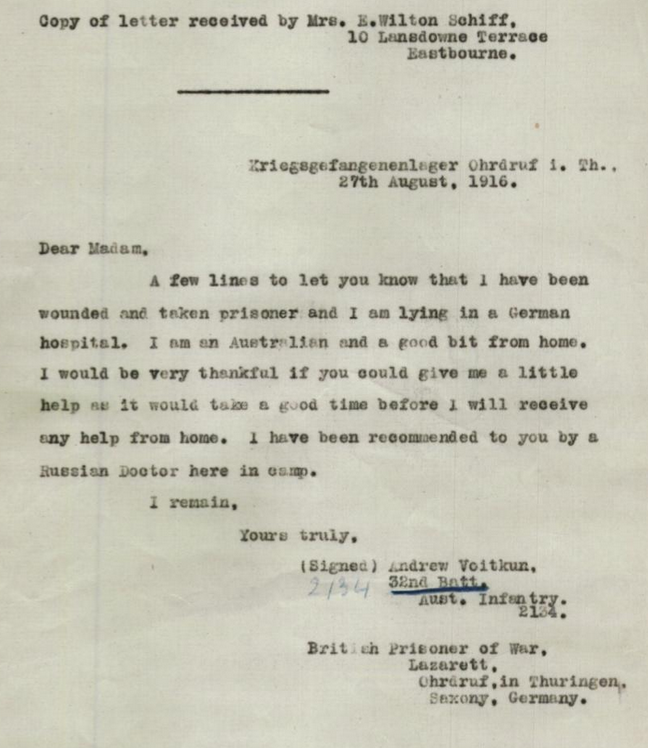
In relation to this letter, the Russian Anzacs website quotes Elena Govor in her book, Russian Anzacs in Australia (2005):
”Andreas …who left his Latvian-born wife and five children at Port Pirie, was not naturalized but seems to have had no hesitation in identifying himself as an Australian: “I am an Australian”, he says, “and a good bit from home”. This is how his 'comrade', an English fellow-prisoner, also sees him: “There is here an Australian married with a family of 5 children who speaks German, Russian and French”, he writes to his sister. “He acts as interpreter for us English to the Russian Doctors and so in an indirect way is doing his bit to better the lot of us wounded.”
It is interesting that the doctors were Russian, so interpreting would have included the language of their captors, plus those who were interned.
Andrew’s AIF file (page 18) shows that he responded to Mrs Schiff on 25 October 1916 thanking her for her parcel that he had received three days earlier. He noted that at the time of his request to her he “was very badly off indeed. Your parcel is the only one I have had, but my comrades here from England have been very good to me out of the parcels they have received.” He went on to say that he had not had anything from the Red Cross Society as yet but he was very glad that Mrs Schiff had written to them on his behalf and that he knew “it would be a great relief to my family to know I was safe. It was very, very kind of you so to interest yourself in me, and I feel I am very greatly indebted to you.”
On the Russian Anzacs website, Peter Dennis is quoted in his story giving some insight to Andreas’ experience as a POW and its impact:
“His position must have given him some privileges, because after complaining that the white bread sent in parcels from the British Red Cross in Switzerland was not to his liking, arrangements were made for rye bread to be sent in from Sweden. While the stomach was satisfied, at least to some extent, he nurtured the mind by reading Tolstoy's War and Peace, a book that he retained and read annually until just before his death.”
At home in Port Pirie
Emilie did not receive official news of her husband’s whereabouts until May 1917, many months after the battle – though she may have had unofficial news via the Red Cross. By then, Andreas had recovered from his wounds and found himself very much in demand as an interpreter within his camp environment, no doubt working closely with AIF officers and their counterparts from other nations.
Andreas Voitkun survived captivity and was freed on 9th January 1919 and repatriated to Hull, England. He returned to Australia on the ship Plassy in May 1919 and, with two other local men, their welcome home was reported as:
“They were accorded a hearty welcome at Solomontown, where the usual decorations of the railway station were carried out elaborately. The school drum and fife band has made its reappearance, adding much to the heartiness of the welcome. ……. The three returned men were motored to the Town Hall, where they were cordially received by the assembled crowd, including representatives of the various patriotic associations. They were then motored home…….”
The report went on to say that Private Voitkun described his experience as a prisoner of war as ‘rough’.
Andreas renounced his Latvian nationality on the 23rd February 1935 swearing allegiance to His Majesty King George the Fifth and his heirs and successors and he was granted his certificate of naturalisaton on 15 March 1935. His sister, Leontine, had been naturalized in 1925 and his son, Ottokar, was naturalized in 1940. It seems that Andrew never returned to his country of birth though his wife returned briefly to Latvia in 1935, with her sister-in-law Leontine, to deal with family matters.
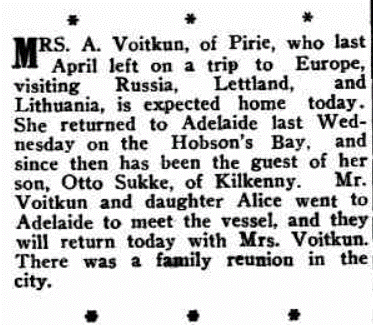
Andreas completed 40 years’ service in the Port Pirie lead smelter. In 1951 about 60 of his workmates presented ‘Andy’ with a wristlet watch and travelling rug, wishing him continued health and comfort in his retirement.
Responding, Andy said that he had had many happy times among his comrades and in Pirie generally. He had come here from the sea 40 years ago, having left his boat in Western Australia and worked his way to this State. He had never regretted having come to Pirie and been associated with the silver-lead industry. He thanked his old work mates for their wishes and thoughtful gesture.
Andreas died on the 25th May 1971 in Adelaide and was buried in Centennial Park Cemetery, Pasadena, Mitcham City, South Australia.
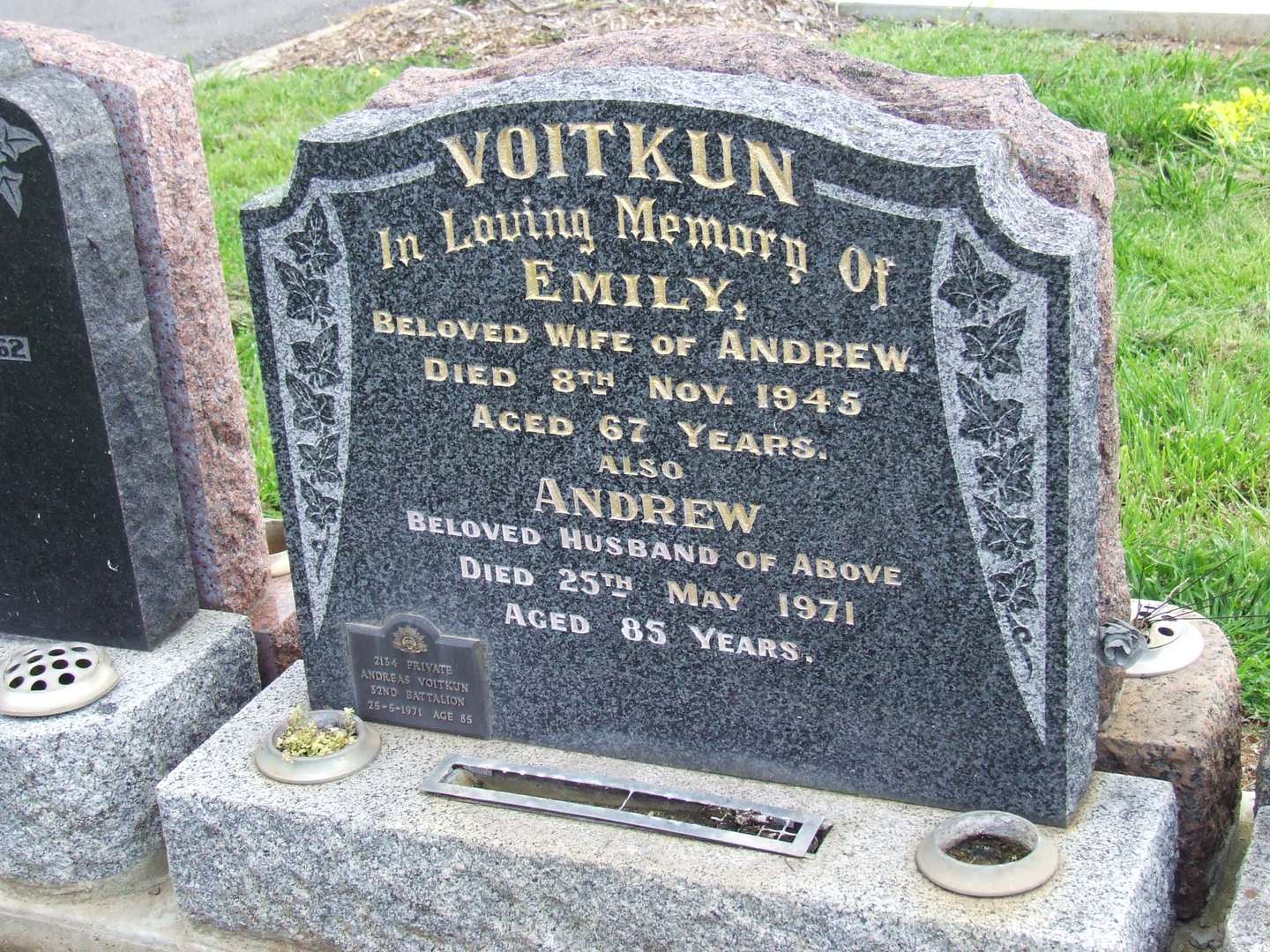
The Fromelles Association would love to hear from you

Contacts
(Contact: royce@fromelles.info or geoffrey@fromelles.info).
(Contact: army.uwc@defence.gov.au or phone 1800 019 090).
Donations
If you are able, please contribute to the upkeep of this resource.
(Contact: bill@fromelles.info ).